Quick Read
- With TikTok potentially facing the boot from the US, you might be deprioritizing vertical.
- TikTok, Instagram Stories, Facebook Reels, Snapchat and YouTube Shorts are all extremely similar, and yet they are usually handled by completely different teams
- On Meta for example, stories are usually fed by adapting 1x1s
- Really, to get the best performance: We should be adding a layer across all three, running a unified 9×16 vertical video strategy
The Context
It’s been over a month since the US signed a bill into law which would force Bytedance to either sell TikTok, or face a ban from the US. Time and court appeals will tell whether that ban goes into effect.
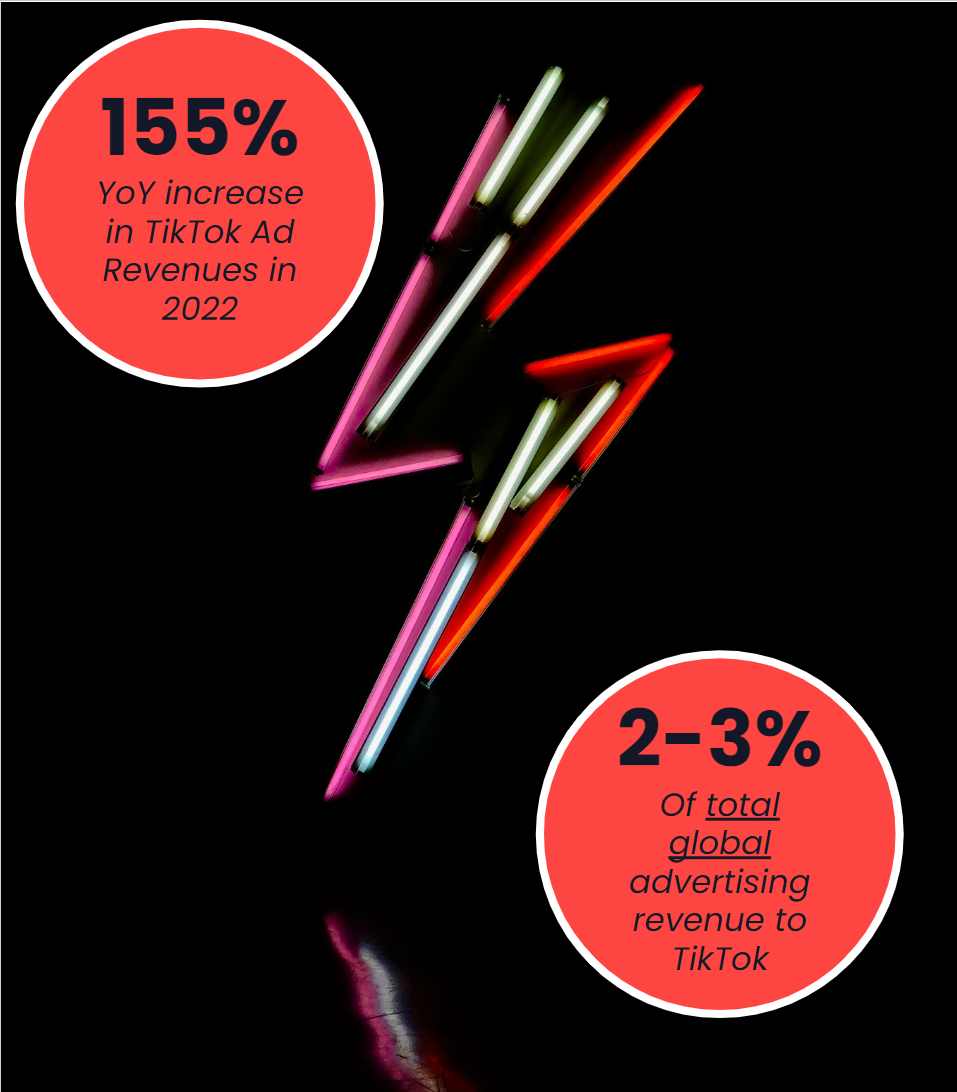
Anyone who’s been in any kind of marketing in the last 5 years knows that TikTok has been the rising player: Their ad revenues rose 155% into 2022, and then another 53% going into 2023. If you have a large amount of spend in TikTok, any kind of a ban could clearly put your business at risk. Or, the threat of a ban might suggest it’s not worth setting up TikTok campaigns right now. You should be drawing the opposite lesson.
TikTok now forms somewhere between 2% and 3% of all global digital ad spend, making it the fourth largest player. To put that into context, Meta and Google have a combined share of around 57% of the market.
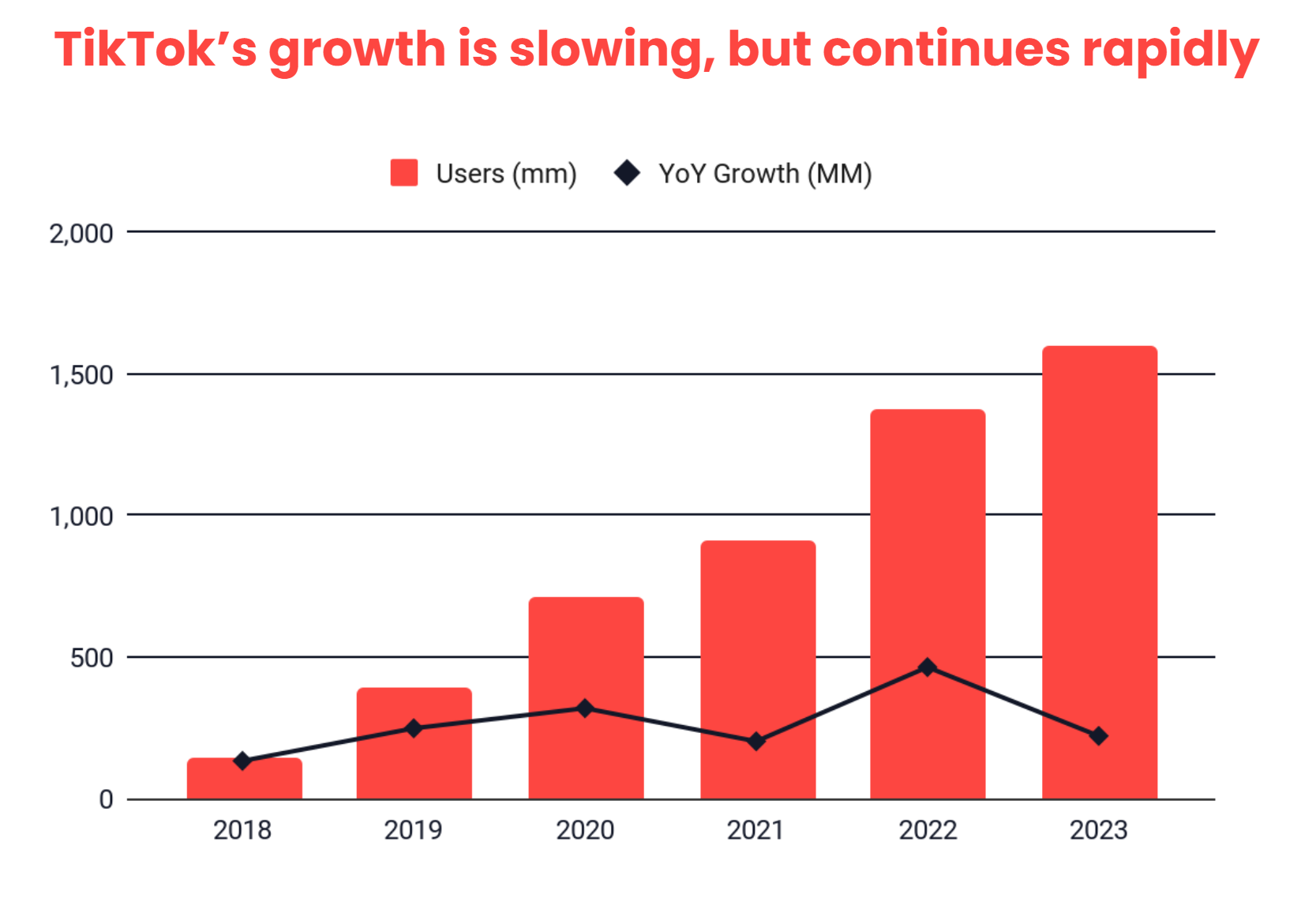
But, that’s just the tip of the iceberg of what TikTok represents and the impact that it’s had on the industry. You should never have been thinking about TikTok just in terms of TikTok. This is the time to double down. Not on TikTok. But, on vertical video.
The vertical, rapid, engaging video format layered with popular music which TikTok made so popular across the planet is here to stay.
That 2-3% market share figure hides the fact that the advertising giants all launched TikTok copycats: from Instagram Stories, Snap Discover and Facebook Reels to more recent- but instantly massive- entrants like YouTube Shorts. Even LinkedIn appears to be testing out a vertical video format again: The fact that this is their second crack at the format- after the infamously short-lived LinkedIn Stories over three years ago- shows that the strategic value even for a LinkedIn audience.
I doubt that most people could tell you five differences between, say, Instagram Stories and TikTok, other than what app they opened them in. This is largely a byproduct of creators posting replica content across all of them at the same time: popular video editing tools like Adobe Premier, and Capcut (Bytedance-owned, and rapidly gaining popularity) allow you to export edited videos directly to multiple social channels.
There is a strong argument to be made that the near identical format and context of these vertical video products warrants transcending a siloed channel approach in favor of a cross-platform approach that can unlock growth multipliers.
Looking at vertical video beyond TikTok provides major benefits
1. Scale
The first benefit of a vertical video strategy which transcends channel silos is scale. You can share learnings among a far greater audience than just TikTok. Yes, TikTok is massive, but its 1.2B MAU pales in comparison to many other channels.
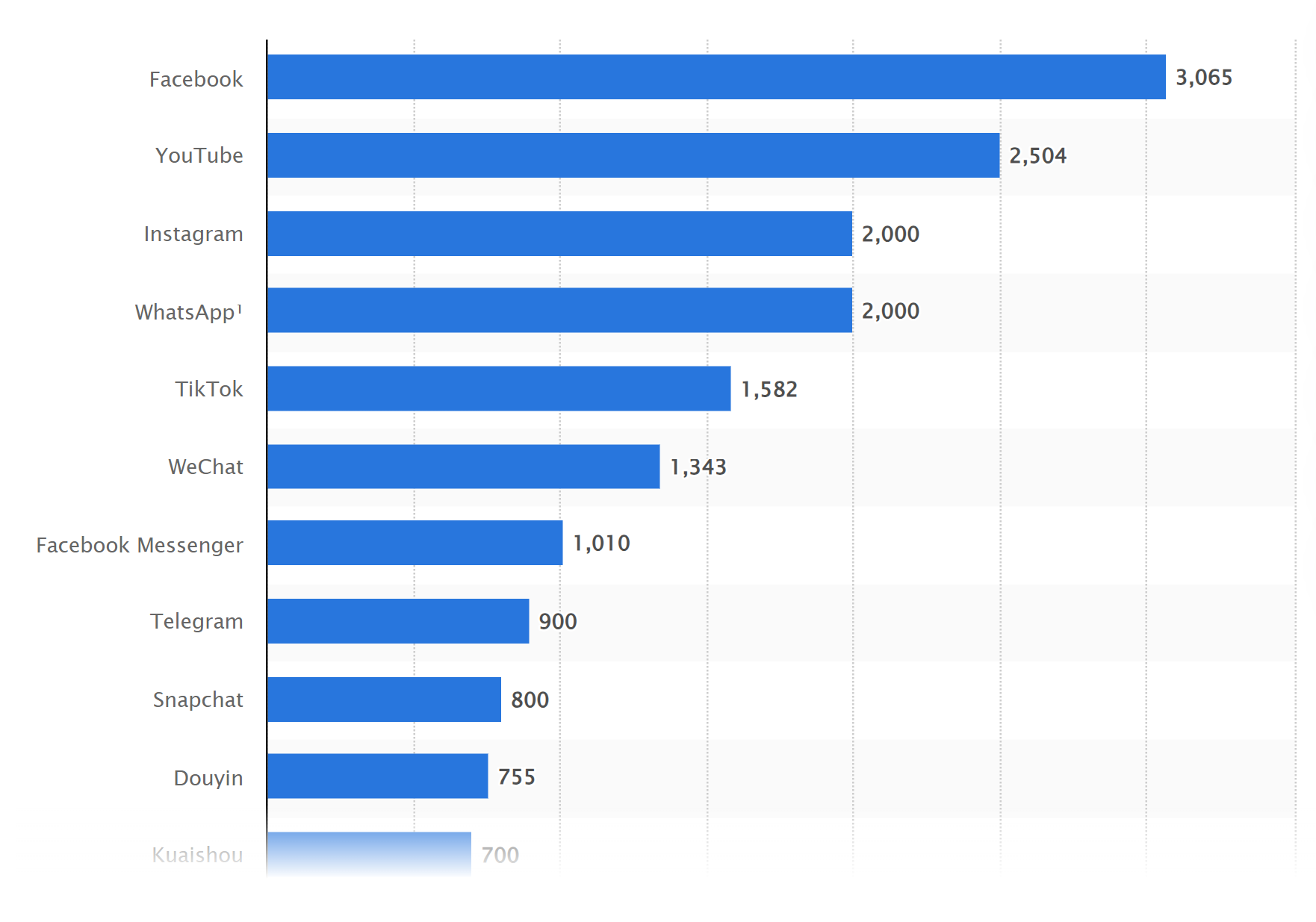
Most popular social networks worldwide as of January 2024 (in millions)
YouTube alone is the second biggest social media channel by number of users. We don’t have the proportion of users on Shorts, but can assume those place fairly close to those from TikTok.
And, whilst TikTok was the most downloaded app of 2023, six of the remaining nine were built by Meta. Instagram alone is nearly twice as large as TikTok.
It’s not just benefits from the extra impression opportunities- you can take learnings from TikTok and apply them to smaller channels. Snapchat, for example, has been left behind with TikTok’s popularity, but still has a major audience among younger demographics. If you apply your learnings from other vertical channels, you get those benefits of scale.
In migrating your TikTok strategy to a vertical video strategy, you expand your non-unique addressable audience 7X – from 1.2B to 9.5B.
2. Hit your entire audience
Expanding your reach across multiple channels provides a benefit beyond pure scale: It increases your chance of hitting your entire audience.
Particularly if you have a pretty niche audience, that audience might not show up in one channel. Think about your own social media feeds: they likely look very different from platform to platform. YouTube Shorts may have picked up on your interest in Baking, whereas TikTok is feeding off your obsession with nature conservation. We have different digital personalities on different platforms.
So, by running a coordinated vertical video strategy that expands beyond TikTok, you increase your likelihood of capturing your full audience. Repeatedly, we’ve found that when we expand to and out of channels like TikTok we’ve seen high rates of net new users, even if we targeted very similar audiences.
And, when the purchase cycle is short, you want to hit in-market audiences as quickly as possible. The in-market time for something like a pair of trousers is likely to last a matter of days. You want to show up, and your best chance of showing up is to be present.
3. Demographics
While the format across TikTok, Instagram Stories or YouTube Shorts is pretty much indistinguishable, their audiences are totally different.
Whereas TikTok notoriously skews younger, YouTube has a much wider reach:
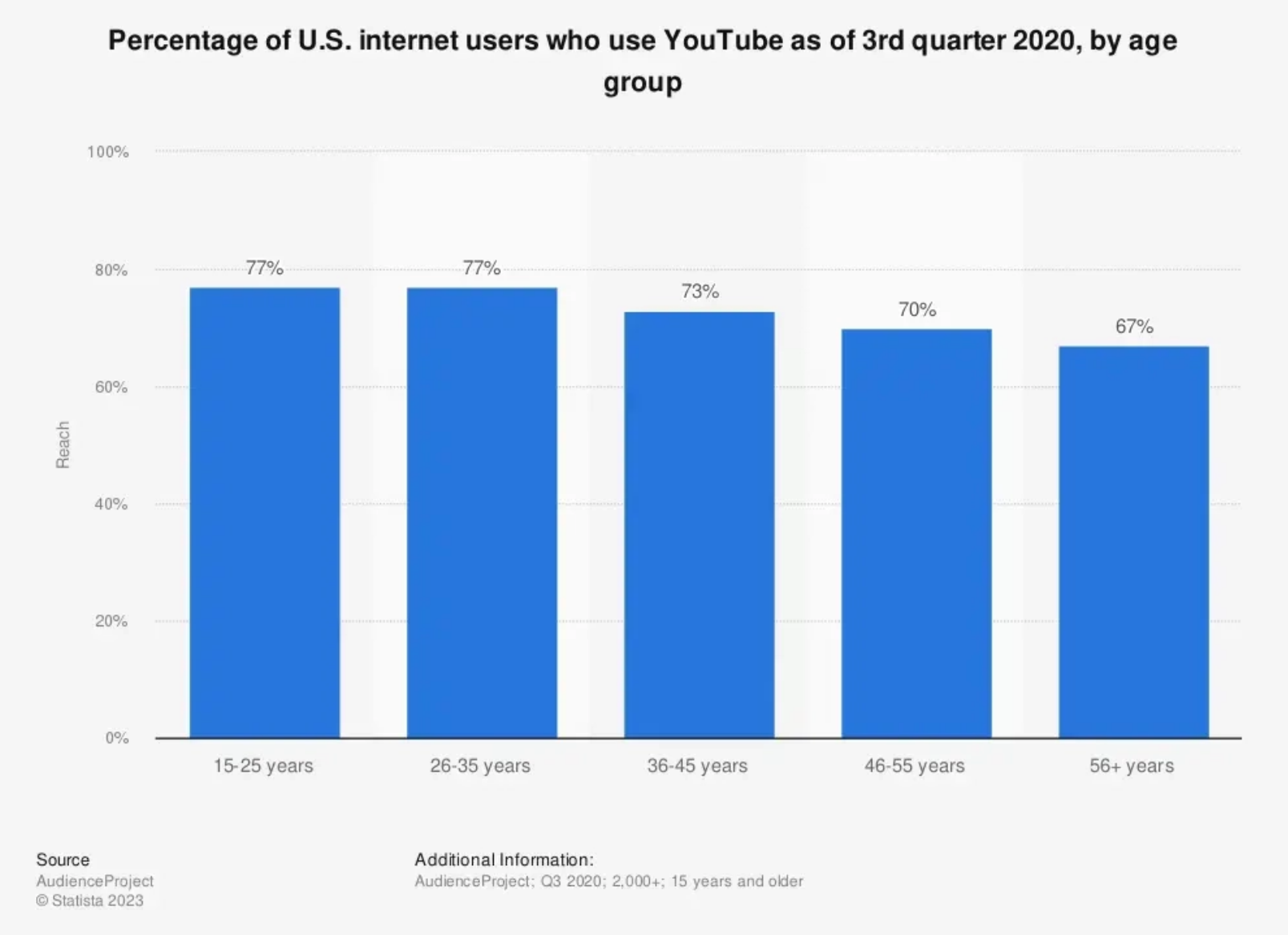
As with Instagram Stories, actual usage of Shorts might skew slightly younger than YouTube as a whole.
But this in itself is a key benefit of expanding out from TikTok: You can pique interest in those young demographics and then retarget video viewers in the multiple more-specialized formats available in that channel. For example:
- Serving a snappy CTA lead-gen ad on the Facebook feed to people who’ve viewed your reel to completion
- Segmenting audiences that have viewed your YouTube Shorts campaigns within Search to drive greater performance
- Or, serving a longer form horizontal video in YouTube to elaborate on your quick Short for interested parties
How do you actually build a vertical video strategy?
We’ve run through the benefits of a coordinated Vertical Video strategy, but how do you actually roll this out?
We’ve split this out into five key action areas:
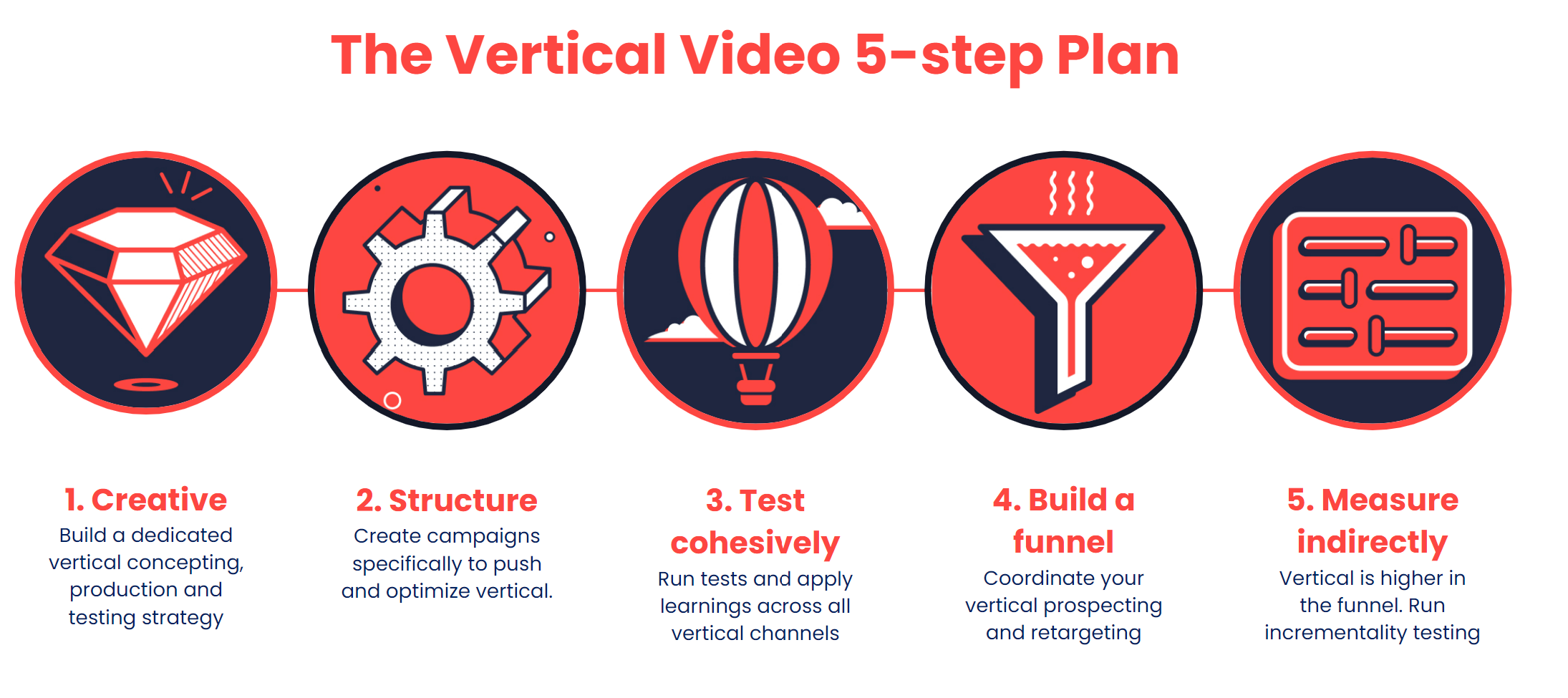
Let’s start with creative:
1. Build a vertical video creative and creative-testing strategy
Creative for vertical video diverges in many ways from the video you design for other formats.
The emerging digital story arc is the most effective form of storytelling on vertical. It has therefore become the dominant one. Open with the bottom-line up-front, and then sustain attention with supporting details from there.
You should be looking to build a shared creative strategy for vertical video. Here are the best tips we’ve found over the course of experimenting with thousands of ad iterations across a wide variety of industries:
First, focus on UGC. Whilst clearly dominant on TikTok, UGC can be a massive ally on all forms of vertical video. When you produce UGC, pay close attention to varying the demographics of your creators – we have a number of indications from testing that this drastically influences the audience that you hit. For example: if you feature a college-age male influencer, delivery will very likely skew towards 18-24 males. We’ve observed this happening with UGC ads across all platforms and you need to plan for it.
Second, test CTA heavy concepts. Whilst UGC dominates ad spend, we’ve found that incorporating both higher and lower-funnel- lower funnel creatives together in the same ad sets has improved performance. The UGC and informative creatives soften up an audience, before the heavier CTA creatives then capitalize on that interest. For this reason, we’ve seen CTA-centric creatives serve much more on retargeting campaigns than on prospecting, and driving stronger results in the process.
Third, have a testing swim-lane for optimizing music and audio. After all, the initial premise of TikTok was short videos with audio overlay. On several occasions, we’ve found the presence of a voice-over (VO), music or, ideally, both has helped performance. In some cases, every single one of our top five performing ads had both a VO and music overlay, whilst all of the bottom five ads had neither.
And fourth, tailor your messaging to each channel. Every vertical channel has a subtly different storytelling framework. Take YouTube Shorts, for example. The clue is in the name: the best performing creatives tend to be a teaser of a longer story, with Shorts typically serving well at luring people into longer-form messaging. Creative best practices on Snap and TikTok both lean more into quicker, snappier messages. Pay attention to the pop-ups, safe zones and brand logo positions for each channel: They differ significantly, and you don’t want a key part of your creatives being blocked by a CTA card.
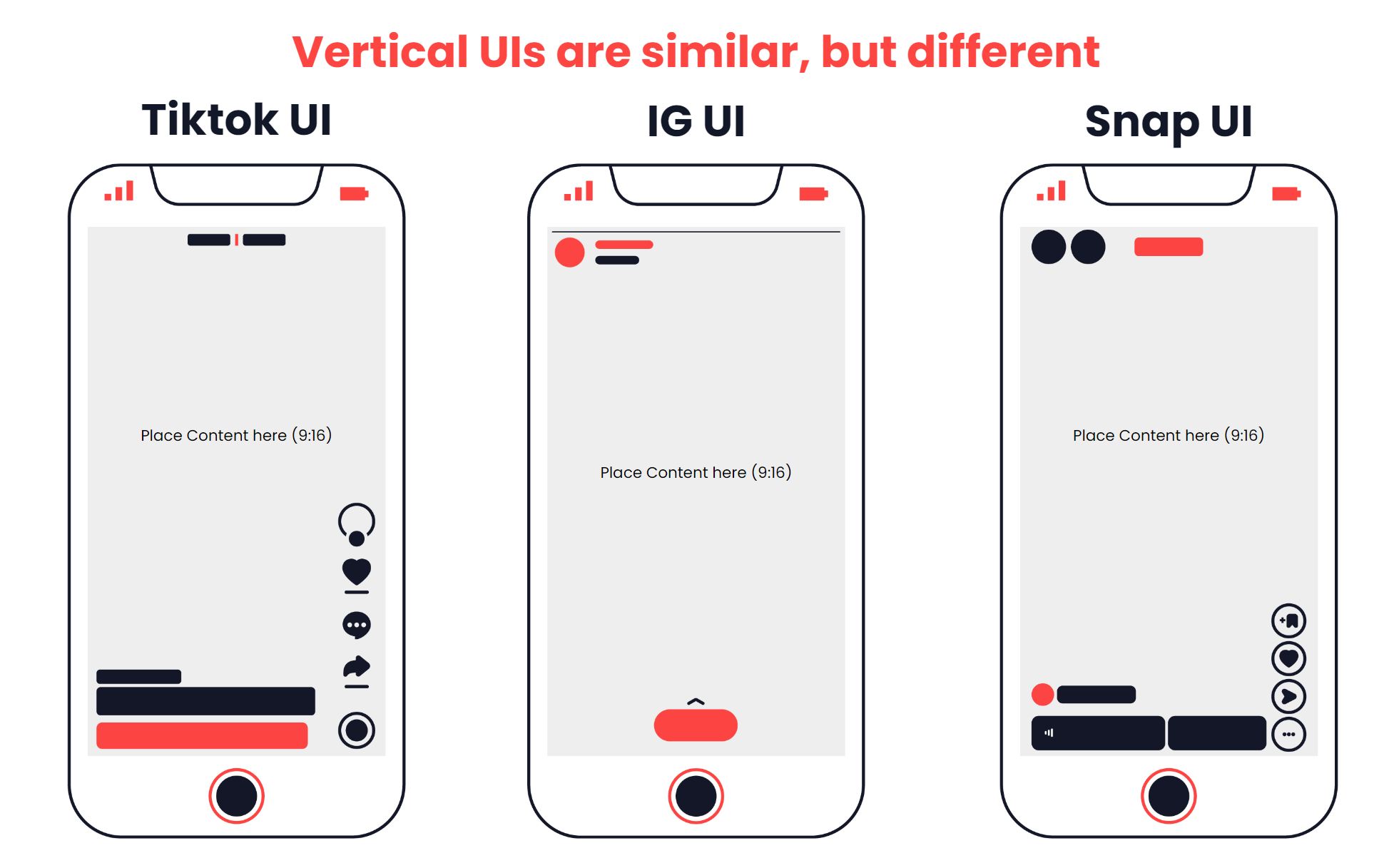
2. Break vertical video out within your structure
To put it simply: split vertical video out into dedicated ad sets on all channels. You can’t just add those videos into existing ad groups and expect them to serve optimally.
On YouTube, for example, there’s no option (at time of writing) to solely target YouTube Shorts. If you’ve felt your vertical videos haven’t performed, it may well be that the campaign setup is causing your ads to serve in the wrong placements. For example, they might show up on desktop, or on mobile just before a user flips their screen, meaning that the video takes up a fraction of the screen for a tiny, incomprehensible ad. You have to hack a few things to force YouTube to serve your vertical videos on Shorts only. There’s more info here which worked at the time of writing.
Similarly, you would have to split your vertical videos out into dedicated ad groups on Meta to specify the placements. But, we actually don’t recommend setting these to vertical placements only. Instead, add resizes of your 9x16s to make them eligible for all placements. The reason for this is that you still want to benefit from the wide scale that Meta offers. It should naturally lean into the vertical placements, as these are the ones that fit most naturally with the creatives.
It’s vital to make sure that your vertical videos are not in the same ad groups as regular statics. If high-converting statics are present, Meta will lean into them as the most clickable ads you have. Your vertical assets will struggle to spend or add anything incremental to your existing ads.
3. Test and iterate cohesively across platforms
This is a simple one that doesn’t happen as often as it should.
Learnings from TikTok apply more actively to YouTube Shorts than the learnings from the rest of your YouTube campaigns. It’s not just the similarity of your creatives, it’s the similarity of the audiences, creatives, products, cadence and more.
By operating a cross-channel vertical video strategy, you suddenly have a learning and experimentation bank from not just a single audience of 250,000 on TikTok, you have a rapid testing program covering millions across YouTube, Meta and TikTok. If you see something driving success in one, it will likely do the same in the others.
This even extends to team structure: does it make sense for you to have someone responsible for vertical video across all channels? Don’t just get your Google person, who probably grew up running Paid Search, suddenly trying to handle your YouTube Shorts. It’s more likely that your TikTok guru can take it to the next level the minute they learn the Google Ads UI.

 By operating a cross-channel vertical video strategy, you suddenly have a learning and experimentation bank from not just a single audience of 250,000 on TikTok, you have a rapid testing program covering millions across YouTube, Meta and TikTok. If you see something driving success in one, it will likely do the same in the others.
By operating a cross-channel vertical video strategy, you suddenly have a learning and experimentation bank from not just a single audience of 250,000 on TikTok, you have a rapid testing program covering millions across YouTube, Meta and TikTok. If you see something driving success in one, it will likely do the same in the others.
4. Coordinate your funnel
As a video-led strategy, vertical video campaigns will inevitably be slightly higher in the funnel than your pure performance campaigns. But, they can work across the funnel.
We’ve found the below approaches exceptionally impactful for our clients in driving success here.
Retargeting high percentage video viewers (e.g. 50%+ complete), either with a CTA ad to drive that conversion, or with a longer form video on YouTube to expand on our story.
Within your creatives, bridge the gap between your upper funnel UGC and your lower funnel assets. When a user sees your CTA ad, they should instantly remember the great UGC which explained all the benefits to them. To do this, instill a common thread linking your UGCs to your lower funnel creative- you could have your creators holding prop, for example, that reappears in your CTA ads. It could be something as simple as a unified color scheme for your captions.
5. Invest in measuring indirect impact
Finally, because vertical video is slightly higher up the funnel, you have to measure it differently to your performance campaigns. These videos will have higher engagement, but they are inherently less clickable. They are not quite brand awareness, but they are not your typical sales ads. This makes them show up poorly in any purely click-based attribution model.
There is a greater need here to measure indirect/incremental returns. How to do this is too large a topic to fit into this piece, but we’ve built a measurement stack to gather these insights. Getting this degree of feedback is absolutely vital to measuring the impact of your vertical video strategy, and getting the insights you need to make it better.
In conclusion
Marketers have a natural tendency to default towards a channel-bucketed lens when it comes to planning and optimizing acquisition media efforts. Some bigger top-down audience activations or omnichannel creative campaigns can be an exception to this, but we’ve yet to encounter an org thinking laterally about its vertical video strategy.
This format has been a dominant influence on how people are consuming media over the past three to five years, and we benefit from treating it independently rather than as an “add-on” to our Meta placements. Standing a vertical video strategy up doesn’t require any radical changes in team structure or workflow, but primarily a shift in planning and perspective.
In the planning phase, pay particular attention to:
- Building a vertical video creative and creative-testing strategy
- How you’ll vertical video out within your campaign structure
- Building a cohesive testing and iteration process specifically for vertical video
- How are you going to join together your funnel?
- How are you going to measure the largely indirect impact?
At Headlight we’ve made vertical video one of our core strategic focus areas for 2024. If you have questions on how to successfully stand up a cohesive strategy or would like support from a team of experts, reach out below.
Headlight’s team of experts are offering a free strategic Audit Session across Growth, Creative & Analytics – a unique opportunity for brands to learn more about how to scale spend with incrementality in mind.



